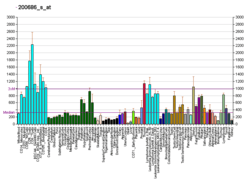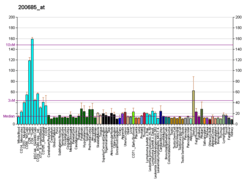SFRS11
Splicing factor, arginine/serine-rich 11 is a protein that in humans is encoded by the SFRS11 gene.[5][6]
This gene encodes 54-kD nuclear protein that contains an arginine/serine-rich region similar to segments found in pre-mRNA splicing factors. Although the function of this protein is not yet known, structure and immunolocalization data suggest that it may play a role in pre-mRNA processing.[6]
Interactions
SFRS11 has been shown to interact with U2AF2.[7]
gollark: ~~I am still annoyed about my hatchery being shut down by TJ09 because of ridiculous selective enforcement of reverse engineering terms - it half-fixed viewbombing by taking out eggs which had unsafe amounts of views~~
gollark: I think it's pinned somewhere here.
gollark: Ah, it's on a calendar thing.
gollark: View depriver...?
gollark: Lunar heralds: Stupidly in demand.
References
- GRCh38: Ensembl release 89: ENSG00000116754 - Ensembl, May 2017
- GRCm38: Ensembl release 89: ENSMUSG00000055436 - Ensembl, May 2017
- "Human PubMed Reference:". National Center for Biotechnology Information, U.S. National Library of Medicine.
- "Mouse PubMed Reference:". National Center for Biotechnology Information, U.S. National Library of Medicine.
- Chaudhary N; McMahon C; Blobel G (October 1991). "Primary structure of a human arginine-rich nuclear protein that colocalizes with spliceosome components". Proc Natl Acad Sci U S A. 88 (18): 8189–93. Bibcode:1991PNAS...88.8189C. doi:10.1073/pnas.88.18.8189. PMC 52472. PMID 1896467.
- "Entrez Gene: SFRS11 splicing factor, arginine/serine-rich 11".
- Zhang, W J; Wu J Y (October 1996). "Functional properties of p54, a novel SR protein active in constitutive and alternative splicing". Mol. Cell. Biol. UNITED STATES. 16 (10): 5400–8. doi:10.1128/MCB.16.10.5400. ISSN 0270-7306. PMC 231539. PMID 8816452.
Further reading
- Zhang WJ; Wu JY (1996). "Functional properties of p54, a novel SR protein active in constitutive and alternative splicing". Mol. Cell. Biol. 16 (10): 5400–8. doi:10.1128/MCB.16.10.5400. PMC 231539. PMID 8816452.
- Straub T, Grue P, Uhse A, et al. (1998). "The RNA-splicing factor PSF/p54 controls DNA-topoisomerase I activity by a direct interaction". J. Biol. Chem. 273 (41): 26261–4. doi:10.1074/jbc.273.41.26261. PMID 9756848.
- Page-McCaw PS; Amonlirdviman K; Sharp PA (2000). "PUF60: a novel U2AF65-related splicing activity". RNA. 5 (12): 1548–60. doi:10.1017/S1355838299991938. PMC 1369877. PMID 10606266.
- Strausberg RL, Feingold EA, Grouse LH, et al. (2003). "Generation and initial analysis of more than 15,000 full-length human and mouse cDNA sequences". Proc. Natl. Acad. Sci. U.S.A. 99 (26): 16899–903. Bibcode:2002PNAS...9916899M. doi:10.1073/pnas.242603899. PMC 139241. PMID 12477932.
- Ota T, Suzuki Y, Nishikawa T, et al. (2004). "Complete sequencing and characterization of 21,243 full-length human cDNAs". Nat. Genet. 36 (1): 40–5. doi:10.1038/ng1285. PMID 14702039.
- Sakashita E, Tatsumi S, Werner D, et al. (2004). "Human RNPS1 and its associated factors: a versatile alternative pre-mRNA splicing regulator in vivo". Mol. Cell. Biol. 24 (3): 1174–87. doi:10.1128/MCB.24.3.1174-1187.2004. PMC 321435. PMID 14729963.
- Wu JY, Kar A, Kuo D, et al. (2006). "SRp54 (SFRS11), a regulator for tau exon 10 alternative splicing identified by an expression cloning strategy". Mol. Cell. Biol. 26 (18): 6739–47. doi:10.1128/MCB.00739-06. PMC 1592875. PMID 16943417.
- Olsen JV, Blagoev B, Gnad F, et al. (2006). "Global, in vivo, and site-specific phosphorylation dynamics in signaling networks". Cell. 127 (3): 635–48. doi:10.1016/j.cell.2006.09.026. PMID 17081983.
- Ewing RM, Chu P, Elisma F, et al. (2007). "Large-scale mapping of human protein-protein interactions by mass spectrometry". Mol. Syst. Biol. 3 (1): 89. doi:10.1038/msb4100134. PMC 1847948. PMID 17353931.
This article is issued from Wikipedia. The text is licensed under Creative Commons - Attribution - Sharealike. Additional terms may apply for the media files.





